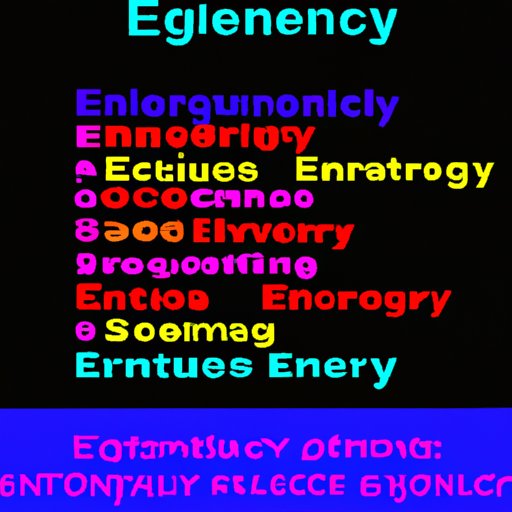Introduction
Energy is a fundamental concept in science, but what exactly is it? This article provides an overview of energy in science and explains the definition of energy in terms of its various forms and applications. From the laws of conservation of energy to the impact of energy on climate change, this article will explore the many facets of energy in science.

Exploring Different Types of Energy in Science
The first step in understanding energy in science is exploring the various forms that it can take. According to the Law of Conservation of Energy, energy can neither be created nor destroyed—it simply changes form. Some of the most common forms of energy include kinetic, potential, chemical, and thermal energy.
Kinetic energy is the energy of motion. It is the energy possessed by an object due to its motion. An example of kinetic energy is the energy of a moving car. Potential energy, on the other hand, is the energy stored in an object due to its position or configuration. An example of potential energy is the energy stored in a stretched rubber band.
Chemical energy is the energy stored in the bonds between atoms. An example of chemical energy is the energy stored in gasoline. Thermal energy is the energy associated with the temperature of an object. An example of thermal energy is the energy of a hot cup of coffee.
Explaining the Laws of Conservation of Energy
The Law of Conservation of Energy states that energy cannot be created or destroyed, only transformed from one form to another. This law is based on two principles: the First Law of Thermodynamics and the Second Law of Thermodynamics.
The First Law of Thermodynamics states that the total amount of energy in a closed system remains constant. In other words, energy can be transferred from one form to another, but the total amount of energy present in the system remains the same. The Second Law of Thermodynamics states that the entropy of a closed system always increases over time. In other words, energy tends to become more dispersed and less useful over time.

Examining How We Use Energy in Everyday Life
We use energy in a variety of ways in our everyday lives. The most common sources of energy are fossil fuels, nuclear power, and renewable sources. Fossil fuels are non-renewable sources of energy such as coal, oil, and natural gas. These sources of energy are finite, meaning they will eventually run out. Nuclear power is also a non-renewable source of energy generated through the splitting of atoms. Renewable sources of energy, such as solar, wind, and geothermal energy, are sources of energy that can be replenished naturally over time.
Exploring the Potential of Renewable Energy Sources
Renewable energy sources have the potential to provide a clean, sustainable source of energy for generations to come. Solar energy is energy from the sun that can be harnessed and converted into electricity. Wind energy is energy generated from the movement of air, which can be used to power turbines. Geothermal energy is energy generated from heat stored deep within the earth, which can be used to generate electricity.

Investigating the Role of Energy in Climate Change
The burning of fossil fuels is a major contributor to climate change. When these fuels are burned, they release greenhouse gases such as carbon dioxide and methane into the atmosphere. These gases trap heat, causing global temperatures to rise. In addition, burning fossil fuels releases large amounts of carbon into the atmosphere, which can further contribute to climate change.
It is clear that energy plays a significant role in climate change. Reducing our reliance on fossil fuels and increasing our use of renewable energy sources can help reduce the effects of climate change. By increasing our use of renewable sources of energy, we can reduce our carbon emissions and help protect the planet.
Conclusion
In conclusion, energy is an essential concept in science. This article has explored the definition of energy in science, including different types of energy, the laws of conservation of energy, how we use energy in everyday life, the potential of renewable energy sources, and the role of energy in climate change. By understanding energy in science, we can work towards reducing our reliance on fossil fuels and increasing our use of renewable sources of energy to help protect the planet.
(Note: Is this article not meeting your expectations? Do you have knowledge or insights to share? Unlock new opportunities and expand your reach by joining our authors team. Click Registration to join us and share your expertise with our readers.)
